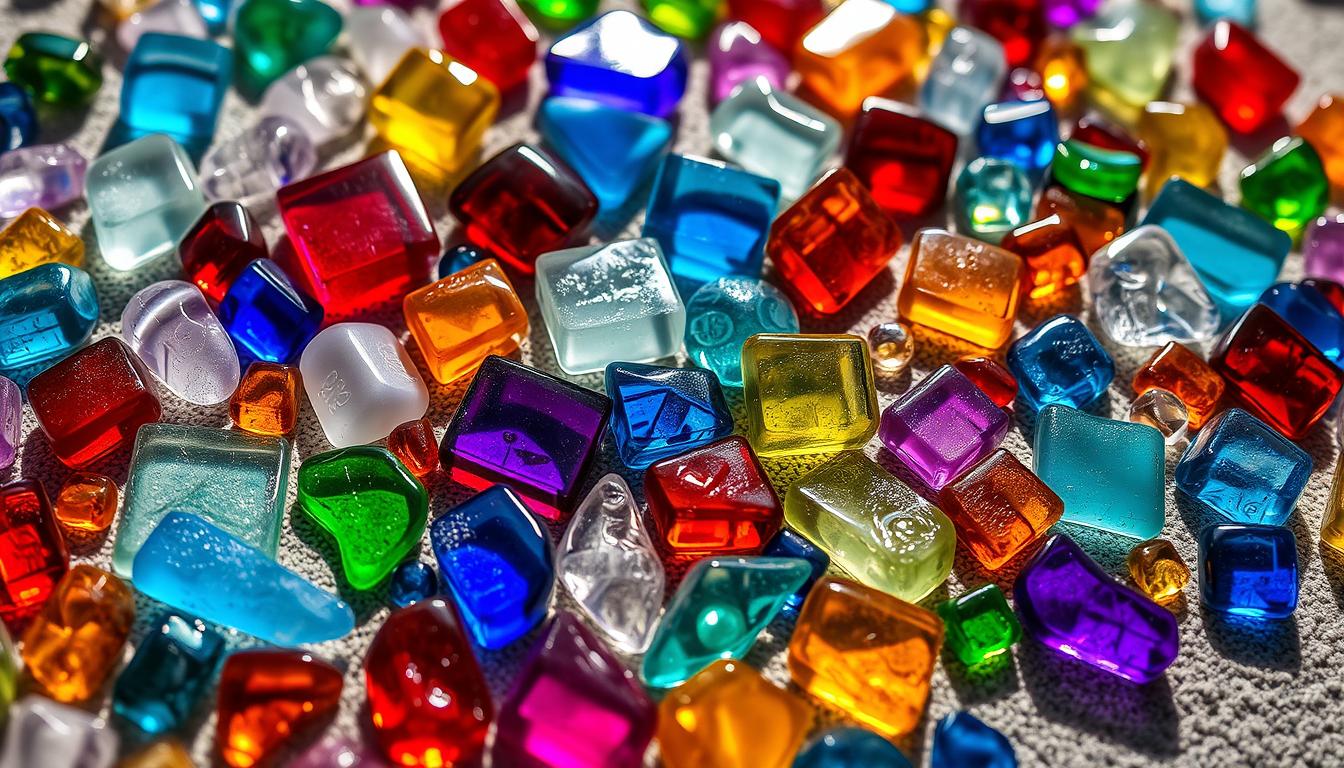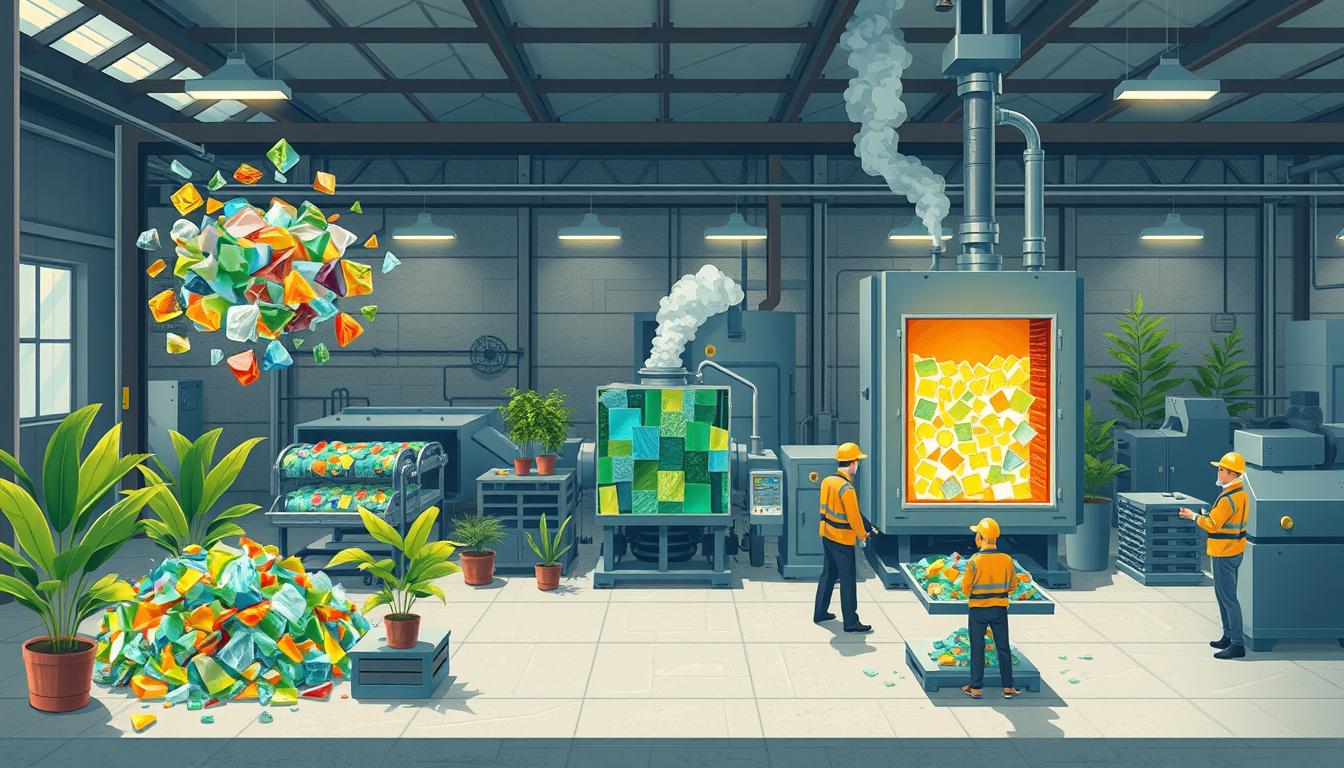Recycled Glass Tiles and Its Environmental Benefits
Posted by Mike Belk on Feb 13, 2016

As I looked at my old kitchen, I felt guilty. I wanted to update it but also be kind to the planet. That's when I found recycled glass tiles, which changed my home and my mind.
Recycled glass tiles mix green living with great looks. They turn old glass into something beautiful. These tiles make any room look amazing and help our planet too.

BELK Tile has a wide range of recycled glass tiles. They come in shapes like squares, bricks, and hexagons. This lets you get creative with your design, whether it's for your kitchen, bathroom, or pool.
Choosing recycled glass tiles is good for the earth. Recycling glass saves a lot of natural resources. It's a clean way to make tiles, with no waste or by-products.
Key Takeaways
- Recycled glass tiles combine sustainability with elegant design
- Available in various colors, shapes, and textures for versatile applications
- Suitable for kitchens, bathrooms, pools, and high-traffic areas
- Manufactured through a waste-free, closed-cycle process
- Contributes significantly to resource conservation and waste reduction
- Offers durability and moisture resistance comparable to traditional tiles
Introduction to Recycled Glass Tiles
Recycled glass tiles are changing the game in green building materials. They mix style with sustainability, making them a favorite for eco-friendly design. Let's dive into the world of repurposed glass in home decor.
What are recycled glass tiles?
Recycled glass tiles come from old glass waste. They're made by melting this waste at over 2000 degrees Fahrenheit. This process makes strong, versatile tiles for homes and businesses.

Environmental benefits of using recycled glass
Using recycled glass in tiles has big environmental pluses:
- It cuts air pollution by 20% and water pollution by up to 50%
- It uses up to 40% less energy than making new glass
- It saves over a ton of raw materials for every ton of glass recycled
- It reduces landfill waste since glass tiles can be recycled
The rise of eco-conscious design
As people focus more on sustainability, recycled glass tiles are getting more popular. They come in many colors like blue, green, and gray. These tiles work well for walls, floors, and more, making homes greener.
| Feature | Benefit |
|---|---|
| Stain and chemical resistance | Ideal for kitchen backsplashes |
| Subway style options | Creates movement and expansiveness |
| Variety of sizes | Allows for customized designs |
| Affordability | Cost-effective alternative to marble |
Recycled glass tiles are durable, stylish, and good for the planet. They're leading the way to sustainable, chic interiors.
The Manufacturing Process of Recycled Glass Tiles
Recycled glass tiles are a top choice for sustainable building. They start with old glass bottles and containers, keeping them out of landfills. This turns waste into stunning, useful items.
First, the glass is sorted by color and type. It's then cleaned to get rid of dirt. Next, it's crushed into small pieces called cullet.
For big glass tiles, they go through an extra step. They're baked in an oven at 500°C for hours. This makes them strong and durable.
Color pigments are mixed in during melting. The glass is then shaped into tiles and cooled slowly. Some products use up to 98% recycled glass, cutting down on waste.
| Environmental Impact | Traditional Tiles | Recycled Glass Tiles |
|---|---|---|
| Air Pollution | Higher | 20% Reduction |
| Water Pollution | Higher | 50% Reduction |
| Energy Savings | Lower | 30% More Efficient |
This green way of making tiles saves resources and makes high-quality products. Recycled glass tiles are strong and good for the planet, perfect for many uses.

Versatility in Design: Colors, Patterns, and Shapes
Recycled glass tiles open up a world of design. They have unique, slightly irregular looks because they're made from recycled materials. With many colors, shapes, and sizes, they offer endless design options for any style.
Vibrant Color Palettes Available
The colors of recycled glass tiles range from soft earth tones to bright hues. Iridescent tiles have a special coating that shimmers and changes colors as you move around them. This adds depth and interest to any area.
Unique Shapes and Patterns
Recycled glass tiles come in shapes like squares, rectangles, hexagons, and penny rounds. Textured tiles have raised patterns that make surfaces stand out. These options let you create detailed patterns and designs, great for accent walls or floors.
Customization Options
Custom glass tile designs offer endless possibilities. Designers can blend colors, shapes, and textures for unique installations. This flexibility makes them perfect for many design styles, from modern to traditional. Glass tiles also reflect light, making rooms brighter and more welcoming.
- Mix different shapes for unique patterns
- Combine colors to create custom gradients
- Use textured tiles for added visual interest
- Incorporate iridescent tiles for a dynamic effect
Recycled glass tiles offer endless design possibilities. Their flexibility and eco-friendly nature make them great for homes and businesses looking for stylish, sustainable options.
Applications for Recycled Glass Tile
Recycled glass tiles are perfect for making homes and businesses more eco-friendly. They are popular in many places because they are stylish and durable. This makes them great for any room.
In kitchens, they make a great backsplash. They add color and are easy to clean. Bathrooms look amazing with these tiles on walls, floors, and in showers. They even work well outside, like on patios and pool areas.
- Small mosaic tiles (1/2" x 1/2", 3/4" x 3/4", 1" x 1")
- Medium-sized options (2" x 2", 3" x 3", 4" x 4")
- Larger format tiles (6" x 6", 12" x 12", 12" x 24")
There are special designs like "Chiseled Dreams" and "Luxacious Bay". They have unique shapes like picket elongated hexagons and 1-inch hexagon mosaics. This lets designers get creative with glass tiles, from walls to floors.
Commercial spaces also love these tiles. They're perfect for places that get a lot of foot traffic. They're easy to keep clean and come in many colors and patterns. This makes them great for creating beautiful, eco-friendly spaces.
Durability and Maintenance of Recycled Glass Tile
Recycled glass tiles are very durable and easy to care for. They are great for homes and businesses. These tiles last longer than many other types of tiles.
Resistance to Stains and Chemicals
Recycled glass tiles are also good at fighting stains and chemicals. They don't soak up liquids or chemicals. This makes them perfect for places where spills happen often.
Cleaning and Care Instructions
Cleaning these tiles is easy. Just use a damp cloth or a mild detergent. Stay away from harsh cleaners to keep the tiles looking good.
Longevity Compared to Traditional Tiles
These tiles also last a long time. They don't need to be replaced often. This makes them a smart choice for saving money in the long run.
| Feature | Recycled Glass Tiles | Traditional Tiles |
|---|---|---|
| Stain Resistance | High | Varies |
| Chemical Resistance | Excellent | Moderate |
| Cleaning Complexity | Simple | Can be complex |
| Color Retention | Long-lasting | May fade over time |
Even though glass tiles cost more upfront, they save money in the long run. As technology improves, they will likely become even more affordable. This makes them a great choice for sustainable and practical flooring.
Innovative Features: Technoclean and Self-Cleaning Properties
Recycled glass tiles are leading the way with new technology. They now come with self-cleaning properties, changing how we maintain spaces. These tiles have nano coatings that bring big benefits.
The Technoclean treatment is a key feature. It makes the tiles better at fighting dirt, stains, and germs. This is great for places that get a lot of use and need to be cleaned often.
These tiles do more than look good. They help keep areas clean, which is perfect for businesses and homes that are always busy. They need less cleaning, saving time and avoiding harsh chemicals.
| Feature | Benefit |
|---|---|
| Nano Coating | Antimicrobial properties |
| Technoclean Treatment | Resistance to dirt and stains |
| Self-Cleaning Properties | Reduced maintenance |
| Advanced Technology | Improved hygiene |
These recycled glass tiles are not just eco-friendly. They also solve real problems in our homes and offices. Their mix of green and smart tech makes them a top pick for those who value both style and function.
Recycled Glass Tile in Commercial and Residential Spaces
Recycled glass tiles are popular in both commercial and home settings. They are versatile and good for the environment. This makes them a great choice for many places.
Use in High-Traffic Areas
In commercial areas, recycled glass tiles work well in busy spots. They are strong and can handle a lot of use. They also resist stains and moisture, perfect for places that need a lot of cleaning.
Incorporation in Luxury Design Projects
For luxury designs, recycled glass tiles are a top pick. They come in many colors and reflect light beautifully. This adds beauty and class to any room. Designers love them for their ability to create unique patterns and shapes.
Suitability for Various Room Types
Recycled glass tiles fit well in different rooms at home. They're great for:
- Kitchens: They resist stains and are easy to clean
- Bathrooms: They're water-resistant and mold-proof
- Living areas: They're stylish and strong for daily use
- Outdoor spaces: They're weather-resistant and last a long time
Using recycled glass tiles is also good for the planet. One recycled bottle can power a computer for 25 minutes. Recycling glass also cuts down air pollution by 20% and water pollution by 50%.
| Benefit | Impact |
|---|---|
| Energy Savings | 30% less energy than new glass production |
| Recyclability | 100% recyclable, infinite times |
| Durability | Comparable to traditional materials |
| Maintenance | Low, due to non-absorptive nature |
It's easy to see why recycled glass tiles are becoming more popular. They offer sustainability, durability, and style for both commercial and home use.
Installation Techniques and Considerations
Glass tile installation needs careful planning and skill. It's important to hire a professional for a beautiful and lasting result. First, the surface must be prepared well for the tiles to stick to.
Choosing the right adhesive is key for glass tile installation. High-grade adhesives, like acrylic or latex-modified thinsets, are best. They ensure strong bonding, which is crucial for glass.
Spacing is also vital. Glass tiles move more with temperature changes than ceramic ones. So, they should be spaced at least 1/4 inch apart. This helps prevent cracking or loosening over time.
Cutting glass tiles requires special tools and techniques. Wet saws with diamond blades are used for precise cuts. This ensures a clean finish around edges and obstacles.
Grouting glass tiles is a slow and delicate process. It takes longer than with ceramic tiles because glass doesn't absorb moisture. Care must be taken to avoid scratching the glass surface during grout removal.
While DIY might seem appealing, glass tile installation is complex. Prices range from $10 to $30 per square foot for common tiles. Custom options can go over $100. Hiring a professional is a smart choice to protect your investment.
Conclusion
Recycled glass tiles are a top choice for eco-friendly home renovations. They mix style with sustainability, turning waste glass into beautiful designs. With so much glass waste going to landfills, recycling is more important than ever.
These tiles are very versatile. They come in many colors, patterns, and finishes. They're great for kitchens, bathrooms, and even pools. They're also durable and easy to clean, making them perfect for any room.
They can also make spaces brighter by reflecting light. This adds to their energy-saving benefits. As people look for green building materials, recycled glass tiles will become even more popular.
Even though they might be more expensive and not well-known yet, technology is improving. This will make them more affordable and accessible. By using recycled glass tiles, we can make our homes beautiful and help the planet at the same time.
FAQ
What are recycled glass tiles?
Recycled glass tiles are made from old glass waste. They turn waste into beautiful design pieces. These tiles are good for the planet and look great too.
What are the environmental benefits of using recycled glass tiles?
Using recycled glass tiles helps reduce landfill waste. They also save natural resources. Plus, making them uses less energy than regular tiles, making them eco-friendly.
How are recycled glass tiles manufactured?
First, old glass is collected, sorted, and cleaned. Then, it's crushed, melted, and shaped into tiles. Some products use up to 98% recycled glass.
What colors, patterns, and shapes are available for recycled glass tiles?
You can find recycled glass tiles in many colors and patterns. They come in shapes like squares, rectangles, hexagons, and penny rounds. This lets you create unique designs.
Where can recycled glass tiles be used?
You can use them in many places, inside and outside. They're great for kitchen backsplashes, bathroom walls and floors, and even outdoor spaces like patios and pools.
Are recycled glass tiles durable and easy to maintain?
Yes, they're very durable and don't stain easily. They also resist UV rays and mold. Cleaning them is simple with just mild soap and water.
What innovative features do some recycled glass tile collections offer?
Some, like Vidrepur's Nature Collection, have Technoclean technology. This makes them self-cleaning, perfect for busy areas.
Where are recycled glass tiles commonly used in commercial and residential spaces?
In offices and public areas, they're chosen for their toughness and easy care. At home, they're great for kitchens, bathrooms, and living rooms, as well as outdoor spaces.
What should be considered when installing recycled glass tiles?
You need to prepare the surface well and use the right adhesives and grouts. It's also important to follow specific installation steps. While DIY is possible, hiring a pro can ensure a better job.



